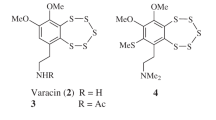Abstract
Scaffolds of 2-acylamino-1,3,4-oxadiazole have been recently developed as transglycosylase inhibitors against MRSA. In the present study, structure–activity relationships of new derivatives of 2-acylamino-1,3,4-oxadiazole were explored with focus on the substitution of the aromatic rings. The in vitro antibacterial activity of these compounds against MRSA strain was evaluated using agar disc diffusion method. These inhibitors have an amide linker between 1,3,4-oxadiazole ring and the aromatic ring B. The role of this linker on the bioactivity of the compounds was also studied. The results showed promising series of 2-α-aminophosphonate-1,3,4-oxadiazole as inhibitors for MRSA strain. Both series revealed two structural features which appear to be essential for anti-MRSA activities, the first one is the incorporation of two electron-withdrawing groups at meta- and para- positions within aromatic ring B which contributed to a higher activity against MRSA strain. The second is the new α-aminophosphonate linker serving as bio-isosteric analogue of the corresponding amide linker and giving comparable results with the amide derivatives.
Graphical abstract




Similar content being viewed by others
References
US Department of Health and Human Services (2013) Antibiotic Resistance Threats in The United States, Section 3: Current Antibiotic Resistance Threats in the United States, by Microorganism. Centers for Disease Control and Prevention, Atlanta
Jevons MP (1961) Br Med J 1:124
Moran GJ, Krishnadasan A, Gorwitz RJ, Fosheim GE, McDougal LK, Carey RB, Talan DA (2006) N Engl J Med 355:666
Hiramatsu K (2001) Lancet Infect Dis 1:147
Wilson P, Andrews JA, Charlesworth R, Walesby R, Singer M, Farrell DJ, Robbins M (2003) J Antimicrob Chemother 51:186
Frazee BW, Lynn J, Charlebois ED, Lambert L, Lowery D, Perdreau-Remington F (2005) Ann Emerg Med 45:311
Fridkin SK, Hageman JC, Morrison M, Sanza LT, Como-Sabetti K, Jernigan JA, Harriman K, Harrison LH, Lynfield R, Farley MM (2005) N Engl J Med 352:1436
Moran GJ, Amii RN, Abrahamian FM, Talan DA (2005) Emerg Infect Dis 11:928
Cheng TJR, Wu YT, Yang ST, Lo KH, Chen SK, Chen YH, Huang WI, Yuan CH, Guo CW, Huang LY, Chen KT, Shih HW, Cheng YSE, Cheng WC, Wong CH (2010) Bioorg Med Chem 18:8512
Zomova AM, Molodykh ZV, Kudryavtseva LA, Teplyakova LV, Fedorov SB, Ivanov BE (1986) Pharm Chem J 20:774
El Gokha A, Ahmed A, Abdelwahed N, El Sayed I (2016) Int J Pharm Sci Rev Res 36:35
El-Boraey HAL, El-Gokha AAA, El-Sayed IET, Azzam MA (2015) Med Chem Res 24:2142
Jin L, Song B, Zhang G, Xu R, Zhang S, Gao X, Hu D, Yang S (2006) Bioorg Med Chem Lett 16:1537
Kukhar VPHH (2000) Aminophosphonic and aminophosphinic acids: chemistry and biological activity. Wiley, Chichester, p 468
Du S, Faiger H, Belakhov V, Baasov T (1999) Bioorg Med Chem 7:2671
Joossens J, Ali OM, El-Sayed I, Surpateanu G, Van der Veken P, Lambeir A-M, Setyono-Han B, Foekens JA, Schneider A, Schmalix W, Haemers A, Augustyns K (2007) J Med Chem 50:6638
Ma J-A (2006) Chem Soc Rev 35:630
Smith AB, Yager KM, Taylor CM (1995) J Am Chem Soc 117:10879
Amir M, Shahani S (1998) Indian J Heterocycl Chem 8:107
Ashour FAAM, Sara A (1990) Alexandria J Pharm Sci 4:29
El-Essawy FA, Boshta NM, Alotaibi MA, Elsayed MS, Tarabees R, Saleh EA (2016) Res Chem Intermed 42:8157
El-Essawy FA, Boshta NM, El-Sawaf AK, Nassar AA, Khalafallah MS (2016) Chem Res Chin Univ 32:967
Nassar OM (1997) Indian J Heterocycl Chem 7:105
Akhter M, Husain A, Azad B, Ajmal M (2009) Eur J Med Chem 44:2372
Küçükgüzel G, Kocatepe A, De Clercq E, Sahin F, Güllüce M (2006) Eur J Med Chem 41:353
Lewis D, Pennington DTM (2017) J Med Chem 60:3552
Ambica KS, Taneja SC, Hundal MS, Kapoor KK (2008) Tetrahedron Lett 49:2208
Azizi N, Saidi MR (2003) Tetrahedron 59:5329
Bhagat S, Chakraborti A (2007) J Org Chem 72:1263
Chandrasekhar S, Prakash SJ, Jagadeshwar V, Narsihmulu C (2001) Tetrahedron Lett 42:5561
Ghosh R, Maiti S, Chakraborty A, Maiti DK (2004) J Mol Catal A Chem 210:53
Heydari A, Hamadi H, Pourayoubi M (2007) Catal Commun 8:1224
Heydari A, Khaksar S, Tajbakhsh M (2009) Tetrahedron Lett 50:77
Kudrimoti S, Rao Bommena V (2005) Tetrahedron Lett 46:1209
Hsueh PR, Teng LJ, Yang PC, Ho SW, Hsieh WC, Luh KT (1997) J Clin Microbiol 35:1021
Clinical and Laboratory Standards Institute (2014) Performance standards for antimicrobial susceptibility testing; Twenty-Fourth informational supplement (M100-S24). Wayne, USA
Kim SW, Lee DG, Choi SM, Park C, Kwon JC, Kim SH, Park SH, Choi JH, Yoo JH, Shin WS (2010) Yonsei Med J 51:722
He H, Xia H, Xia Q, Ren Y, He H (2017) Bioorg Med Chem 25:5652
Garfunkle J, Ezzili C, Rayl TJ, Hochstatter DG, Hwang I, Boger DL (2008) J Med Chem 51:4392
Sandoval E, Lafuente-Monasterio MJ, Almela MJ, Castañeda P, Jiménez Díaz MB, Martínez-Martínez MS, Vidal J, Angulo-Barturen Í, Bamborough P, Burrows J, Cammack N, Chaparro MJ, Coterón JM, de Cozar C, Crespo B, Díaz B, Drewes G, Fernández E, Ferrer-Bazaga S, Fraile MT, Gamo FJ, Ghidelli-Disse S, Gómez R, Haselden J, Huss S, León ML, de Mercado J, Macdonald SJF, Martín Hernando JI, Prats S, Puente M, Rodríguez A, de la Rosa JC, Rueda L, Selenski C, Willis P, Wilson DM, Witty M, Calderón F (2017) J Med Chem 60:6880
Author information
Authors and Affiliations
Corresponding author
Electronic supplementary material
Below is the link to the electronic supplementary material.
Rights and permissions
About this article
Cite this article
Boshta, N.M., Elgamal, E.A. & El-Sayed, I.E.T. Bioactive amide and α-aminophosphonate inhibitors for methicillin-resistant Staphylococcus aureus (MRSA). Monatsh Chem 149, 2349–2358 (2018). https://doi.org/10.1007/s00706-018-2303-y
Received:
Accepted:
Published:
Issue Date:
DOI: https://doi.org/10.1007/s00706-018-2303-y




